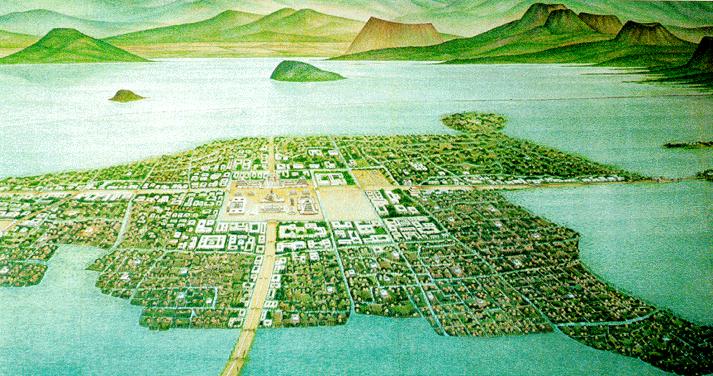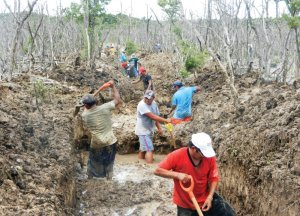Aztec aquaculture : The Chinampas
If the popular belief is that vegetable aquaculture is a result of the appearance of agrochemistry and synthetic fertilizers during the first half of the last century, it turns out that its origins go back to much older times …

Indeed, at the beginning of the 2nd millennium, the Aztecs were already practicing a form of agriculture above ground around their capital Tenochtitlan, located in the middle of Lake Texcoco. This lake, partly marshy, was the ideal place to develop on a large scale a marginal cultivation technique used by the farmers of the bordering lakes Xochimilco and Chalco : the Chinampas.
Chinampas are artificial islands structured by an arrangement of reeds spread out around stakes of wood planted under the surface of the water and which thus formed an underwater fence. Inside, there is a tangle of mud and aquatic vegetation accumulated up to one metre above the surface and which form fertile soil cultivated thereafter. On the surface, willows or cypress trees can be planted at each corner of the installation to secure it.
The construction of these artificial islands was at the time accompanied by an irrigation system allowing the circulation of water, sediments and of course, fishes between chinampas.

Not only did crops not need to worry about the lack of rain, but the Aztecs re-used the nutrient-rich mud that had accumulated at the bottom of the ditches to fertilize their crops. This alternation between artificial islands and water circulation channels gave these buildings the appearance of floating islands or “chinampas” in the local dialect. At the time, this highly productive agroecological farming method was used to feed a large part of the Aztec cities. A few centuries later, this subsistence agriculture is gradually being replaced by intensive greenhouse horticulture that sometimes has a negative impact on the environment. If this activity proves to be much more profitable, it is urgent to highlight the many ecosystem services provided by the culture on chinampas, now in danger of extinction. Mexican lakes are now facing deforestation, congestion of irrigation canals and reduced food self-sufficiency. The chinampas could however resurface thanks to the intervention of a team of researchers who aim to use this technique to reinvigorate the development of mangroves.
A team of Mexican researchers recently managed to restore almost 2 hectares of mangroves in the Los Canates Nature Reserve by planting 3 different mangrove varieties on several hundred chinampas. These structures, perfectly adapted to flood-affected contexts, provide an ideal environment for the development of mangroves. The photo shows Mexican workers digging a watercourse to restore the disappeared mangroves of this site.

Mangroves are very important ecosystems. They feed coastal fishermen, reduce the impact of floods by acting as a buffer zone, they act as an interface between different types of marine and forest ecosystems, give wood to local communities, filter water and are one of the most carbon-intensive ecosystems in the world. Thus, chinampas are more than just ancestors of aquaculture. They used an agro-ecological and low-tech soil-growing method that not only feed the local population when the environment is suitable, but also restore ecosystems characteristic of their environment. At the crossroads between permaculture and aquaponics, chinampas remain a source of inspiration, witness of a lost civilization that continues to amaze us and still reserves some secrets …
Sources :
- Ebel, Roland. s. d. « Chinampas: An Urban Farming Model of the Aztecs and a Solution for the Megalopolis of Our Times ». In . ECO. s. d. « Mangrove Restoration in Key Mexican Coastal Lagoons in the Gulf of Mexico | Featured Stories ». ECO Magazine. Consulté le 11 juillet 2018. https://www.ecomagazine.com/featured-stories/mangrove-restoration-in-key-mexican-coastal-lagoons-in-the-gulf-of-mexico.
- Embarcadero-Jiménez, Salvador, Flor N. Rivera-Orduña, et En Tao Wang. 2016. « Bacterial Communities Estimated by Pyrosequencing in the Soils of Chinampa, a Traditional Sustainable Agro-Ecosystem in Mexico ». Journal of Soils and Sediments 16 (3): 1001‑11. https://doi.org/10.1007/s11368-015-1277-1.
- Merlín-Uribe, Yair, Carlos E. González-Esquivel, Armando Contreras-Hernández, Luis Zambrano, Patricia Moreno-Casasola, et Marta Astier. 2013. « Environmental and Socio-Economic Sustainability of Chinampas (Raised Beds) in Xochimilco, Mexico City ». International Journal of Agricultural Sustainability 11 (3): 216‑33. https://doi.org/10.1080/14735903.2012.726128.
- Embarcadero-Jiménez, Salvador, Flor N. Rivera-Orduña, et En Tao Wang. 2016. « Bacterial Communities Estimated by Pyrosequencing in the Soils of Chinampa, a Traditional Sustainable Agro-Ecosystem in Mexico ». Journal of Soils and Sediments 16 (3): 1001‑11. https://doi.org/10.1007/s11368-015-1277-1.
- Merlín-Uribe, Yair, Carlos E. González-Esquivel, Armando Contreras-Hernández, Luis Zambrano, Patricia Moreno-Casasola, et Marta Astier. 2013. « Environmental and Socio-Economic Sustainability of Chinampas (Raised Beds) in Xochimilco, Mexico City ». International Journal of Agricultural Sustainability 11 (3): 216‑33. https://doi.org/10.1080/14735903.2012.726128.
- ORTIZ-CORNEJO, Nadia Livia, Marco LUNA-GUIDO, Yadira RIVERA-ESPINOZA, María Soledad VÁSQUEZ-MURRIETA, Víctor Manuel RUÍZ-VALDIVIEZO, et Luc DENDOOVEN. s. d. «GREENHOUSE GAS EMISSIONS FROM A CHINAMPA SOIL OR FLOATING GARDENS IN MEXICO », 9.
- « The Aztec Civilization: Aztec Environment ». s. d. The Aztec Civilization (blog). Consulté le 15 juin 2018. http://aztecgroup.blogspot.com/p/aztec-environment.html.

Trackbacks/Pingbacks